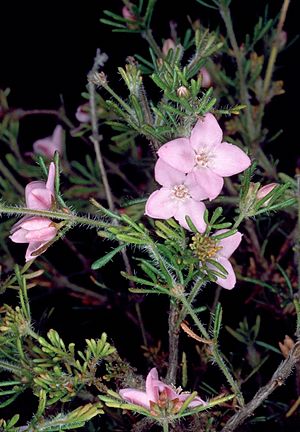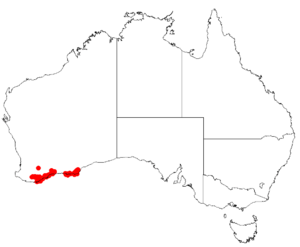Boronia albiflora facts for kids
Quick facts for kids Boronia albiflora |
|
|---|---|
 |
|
| Boronia albiflora in the Australian National Botanic Gardens | |
| Scientific classification | |
 |
|
| Occurrence data from Australasian Virtual Herbarium |
Boronia albiflora is a special plant that belongs to the citrus family, called Rutaceae. It grows only in the south-west part of Western Australia, which means it is endemic there. This plant is a soft shrub with leaves that look a bit like feathers. Its flowers are usually pink or a mix of pink and white, and they have four petals.
Contents
What Does Boronia albiflora Look Like?
Boronia albiflora is a soft, upright shrub. It can grow from about 0.1 m (0.3 ft) to 0.7 m (2 ft) tall. Its stems and branches are covered with short, soft hairs.
Leaves and Flowers
The leaves of this plant are pinnate, meaning they have between seven and eleven smaller parts, like a feather. These small leaf parts are somewhat wedge-shaped and feel leathery. Their edges are often curled under.
The flowers are pink or a mix of pink and white. They grow where the leaves meet the stem, which is called the leaf axil. Each flower has four sepals. Sepals are like small, leaf-shaped parts that protect the flower bud. These sepals are covered with hairs.
The four petals are smooth and do not have hairs. They are about 9–11 mm (0.4–0.4 in) long and overlap at their bases. Inside the flower, the filaments are club-shaped and have a tiny gland at their tip. You can see Boronia albiflora flowering in most months of the year.
How Was Boronia albiflora Named?
Boronia albiflora was first officially described in 1863 by a botanist named George Bentham. He used notes from an earlier, unpublished description by Robert Brown. This description was then shared in a book called Flora Australiensis.
Where Does Boronia albiflora Grow?
This type of boronia plant grows in areas close to the coast. You can find it in the southern parts of the south-west region of Western Australia. It often prefers to grow in sandy soils.
Is Boronia albiflora Endangered?
The Western Australian Government Department of Parks and Wildlife has looked at Boronia albiflora. They have decided that it is "not threatened," which means it is not in danger of disappearing.

